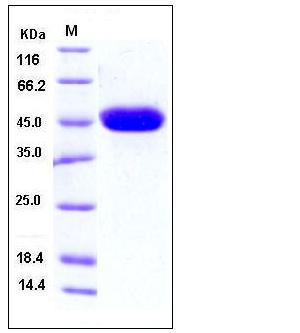Human Carbonic Anhydrase XIV / CA14 Protein (His Tag)
CA14,CAXiV
- 100ug (NPP3635) Please inquiry
| Catalog Number | P10458-H08H |
|---|---|
| Organism Species | Human |
| Host | Human Cells |
| Synonyms | CA14,CAXiV |
| Molecular Weight | The recombinant human CA14 consisting of 286 amino acids and has a calculated molecular mass of 32.3 kDa. As a result of glycosylation, the recombinant protein migrates as an approximately 45-48 kDa protein in SDS-PAGE under reducing conditions. |
| predicted N | Ala 16 |
| SDS-PAGE |  |
| Purity | > 97 % as determined by SDS-PAGE |
| Protein Construction | A DNA sequence encoding the extracellular domain of human CA14 (NP_036245.1) (Met 1-Met 290) was expressed with a C-terminal polyhistidine tag. |
| Bio-activity | |
| Research Area | Cardiovascular |Cardiovascular disease Therapeutic Targets |Hypertension Therapeutic Targets |
| Formulation | Lyophilized from sterile PBS, pH 7.4 1. Normally 5 % - 8 % trehalose, mannitol and 0.01% Tween80 are added as protectants before lyophilization. Specific concentrations are included in the hardcopy of COA. |
| Background | The carbonic anhydrases (or carbonate dehydratases) are classified as metalloenzyme for its zinc ion prosthetic group and form a family of enzymes that catalyze the rapid interconversion of carbon dioxide and water to bicarbonate and protons, a reversible reaction that takes part in maintaining acid-base balance in blood and other tissues. The carbonic anhydrasekl (CA) family consists of at least 11 enzymatically active members and a few inactive homologous proteins. CAXIV is a member of CA family that showed an overall similarity of 29–46% to other active CA isozymes. The highest percentage similarity was with a transmembrane CA isoform, CAXII. The CAXIV was found high concentrations in human heart, brain, liver, and skeletal muscle but lower in the colon, small intestine, urinary bladder, and kidney. No CAXIV mRNA was seen in the salivary gland and pancreas. CAXIV is a likely candidate for the extracellular CA postulated to have an important role in modulating excitatory synaptic transmission in brain. |
| Reference |
